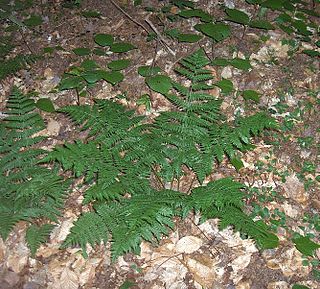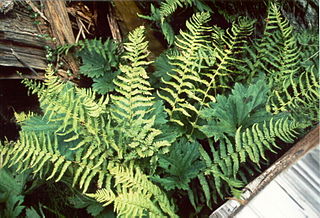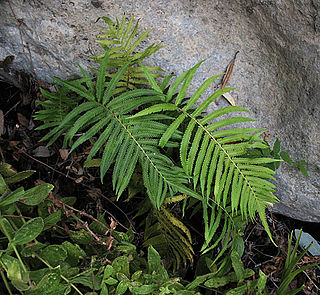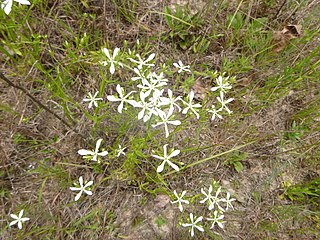
Thelypteridaceae is a family of about 900 species of ferns in the order Polypodiales. In the Pteridophyte Phylogeny Group classification of 2016, it is placed in the suborder Aspleniineae. Alternatively, the family may be submerged in a very broadly defined family Aspleniaceae as the subfamily Thelypteridoideae.

Sabal minor, commonly known as the dwarf palmetto, is a small species of palm. It is native to the deep southeastern and south-central United States and northeastern Mexico. It is naturally found in a diversity of habitats, including maritime forests, swamps, floodplains, and occasionally on drier sites. It is often found growing in calcareous marl soil. Sabal minor is one of the most frost and cold tolerant among North American palms.

Botrypus virginianus, synonym Botrychium virginianum, sometimes called rattlesnake fern is a species of perennial fern in the adders-tongue family. It is monotypic within the genus Botrypus, meaning that it is the only species within the genus. It is called the rattlesnake fern in some parts of North America, due to its habit of growing in places where rattlesnakes are also found. Rattlesnake fern prefers to grow in rich, moist woods in dense shade and will not tolerate direct sunlight.

Thelypteris is a genus of ferns in the subfamily Thelypteridoideae, family Thelypteridaceae, order Polypodiales. Two radically different circumscriptions of the genus are in use as of January 2020. In the Pteridophyte Phylogeny Group classification of 2016, the genus is a very small one with about two species. In other approaches, the genus is the only one in the subfamily Thelypteridoideae, and so includes between 875 and 1083 species.

Dryopteris intermedia, the intermediate wood fern or evergreen wood fern, is a perennial, evergreen wood fern native to eastern North America. It is a diploid species, and is the parent of several species of hybrid origin, including Dryopteris carthusiana. Other common names for this species include intermediate shield fern, fancy wood fern, fancy fern, glandular wood fern, American shield fern and common wood fern.

Amauropelta noveboracensis, the New York fern, is a perennial species of fern found throughout the eastern United States and Canada, from Louisiana to Newfoundland, but most concentrated within Appalachia and the Atlantic Northeast. New York ferns often forms spreading colonies within the forests they inhabit.

Thelypteris palustris, the marsh fern, or eastern marsh fern, is a species of fern native to eastern North America and across Eurasia. It prefers to grow in swamps, bogs, wet fields or thickets, fresh tidal and nontidal marshes, or wooded streambanks. The species epithet palustris is Latin for "of the marsh" and indicates its common habitat. It is the only known host plant for Fagitana littera, the marsh fern moth.

Parathelypteris nevadensis, synonym Thelypteris nevadensis, is a species of fern known by the common names Sierra marsh fern, Sierra wood fern, and Nevada marsh fern. It is native to western North America from British Columbia to the mountains of northern California, where it grows in moist wooded areas, streamsides, meadows, and seeps. It is known from two locations in Idaho, as well. Despite its name it is not found in Nevada, rather, it was named for the Sierra Nevada, where it does occur in the northern mountains. It produces a dense cluster of long, feathery leaves which may be up to a meter long. It is rhizomatous and it sometimes forms colonies. The leaves die back in winter. Each leaf is made up of leaflets lined with smaller segments. The undersides are glandular and resinous and sometimes hairy.

Christella puberula, synonym Thelypteris puberula, is a species of fern known by the common name showy maiden fern. The variety Ch. puberula var. sonorensis is known by the common name Sonoran maiden fern.

Campyloneurum phyllitidis, commonly known as the long strap fern, is a species of fern in the family Polypodiaceae.

Christella is a genus of around 70-80 species of ferns in the subfamily Thelypteridoideae of the family Thelypteridaceae in the Pteridophyte Phylogeny Group classification of 2016. Other sources sink Christella into a very broadly defined genus Thelypteris. The genus was named after Konrad H. Christ, a Swiss botanist. The distribution of these plants is mostly in the tropics and sub tropical areas. An Australian example is C. dentata.
Amauropelta inabonensis, synonym Thelypteris inabonensis, is a rare species of fern known by the common name cordillera maiden fern. It is endemic to Puerto Rico, where it is known from only two localities: at the headwaters of Río Inabón and at the Toro Negro State Forest. It is a federally listed endangered species of the United States.
Stegnogramma pilosa, synonym Thelypteris pilosa, is a fern species in the family Thelypteridaceae. It is closely related to Stegnogramma burksiorum ; the two have been treated as a species complex. Stegnogramma pilosa is native to Mexico, Guatemala and Honduras.
Goniopteris verecunda, synonym Thelypteris verecunda, is a rare species of fern known by the common name Barrio Charcas maiden fern. It is endemic to Puerto Rico, where it is known from only three localities. It is a federally listed endangered species of the United States.

Goniopteris yaucoensis, synonym Thelypteris yaucoensis, is a rare species of fern known by the common name Puerto Rico maiden fern. It is endemic to Puerto Rico, where it is known from only three localities. It is a federally listed endangered species of the United States.

Anchistea is a genus of leptosporangiate ferns in the family Blechnaceae. It has only one species, Anchistea virginica the Virginia chain fern, which has long creeping, scaly, underground stems or rhizomes giving rise to tall widely separated, deciduous, single leaves. In contrast, the leaves of Osmundastrum cinnamomeum, which can be mistaken for A. virginica, grow in a group from a crown. Also in contrast to O. cinnamomeum the leaves are monomorphic without distinct fertile fronds. The lower petiole or stipe is dark purple to black, shiny and swollen, the upper rachis is dull green. The leaf blade is green and lanceolate, composed of 12 to 23 paired, alternate pinnatifid pinnae. The pinnae are subdivided into 15 to 20 paired segments that are ovate to oblong. The lower rachis is naked for about half its length. The sori or spore-producing bodies are found on the underside of the pinnae and are long and form a double row which outlines the major veins of the pinnae. In common with all ferns, A. virginica exhibits a gametophyte stage in its life cycle and develops a haploid reproductive prothallus as an independent plant. The spores are produced in red-brown sori which line the spaces (areolae) between the costa and costules. Further photographs can be found at the Connecticut Botanical Society and Ontario Ferns websites.

Brachiaria mutica is a species of grass known by the common names para grass, buffalo grass, Mauritius signal grass, pasto pare, malojilla, gramalote, parana, Carib grass, and Scotch grass. Despite its common name California grass, it does not occur in California; it is native to northern and central Africa and parts of the Middle East, where it is cultivated for fodder. It was introduced elsewhere and it is now cultivated throughout tropical regions of the world for this purpose.

Sabatia quadrangula, the fourangle rose gentian or four-angle rose-gentian, is a flowering plant native to the eastern United States. It is found in pine savannas, flatwoods, shrub bog borders, ditches, and granite outcrops from Virginia south to the Florida panhandle and west to Alabama.

Coryphopteris simulata, synonym Thelypteris simulata, is a species of fern native to the Northeastern United States. It is known by two common names: bog-fern and Massachusetts fern. It is often confused with the silvery spleenwort, New York fern, and the marsh fern due to similarities in shape and size.

Pelazoneuron ovatum, synonym Thelypteris ovata, the ovate marsh fern or ovate maiden fern, is a species of fern in the Thelypteridaceae family. Native to the southeastern United States, this fern can be found in riverbanks and moist canyons. In Georgia it can be found in the Coastal Plain.

















